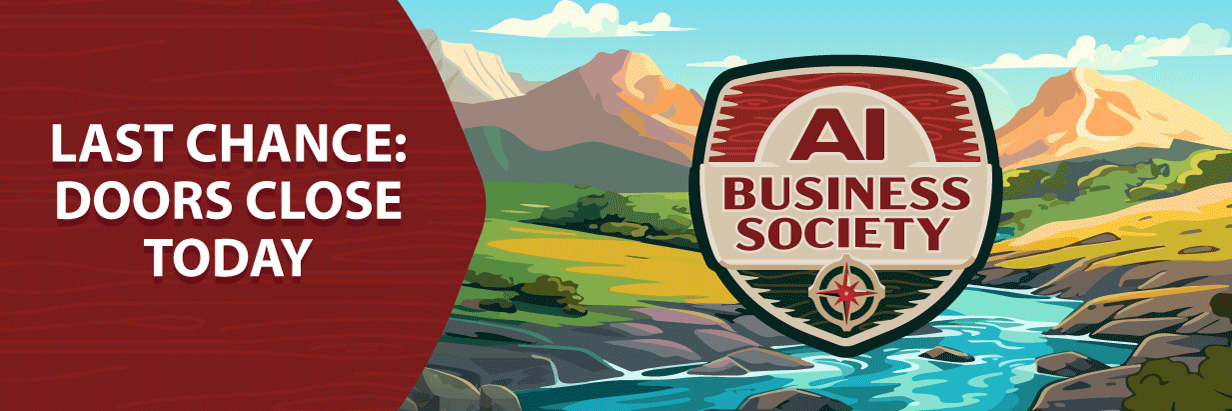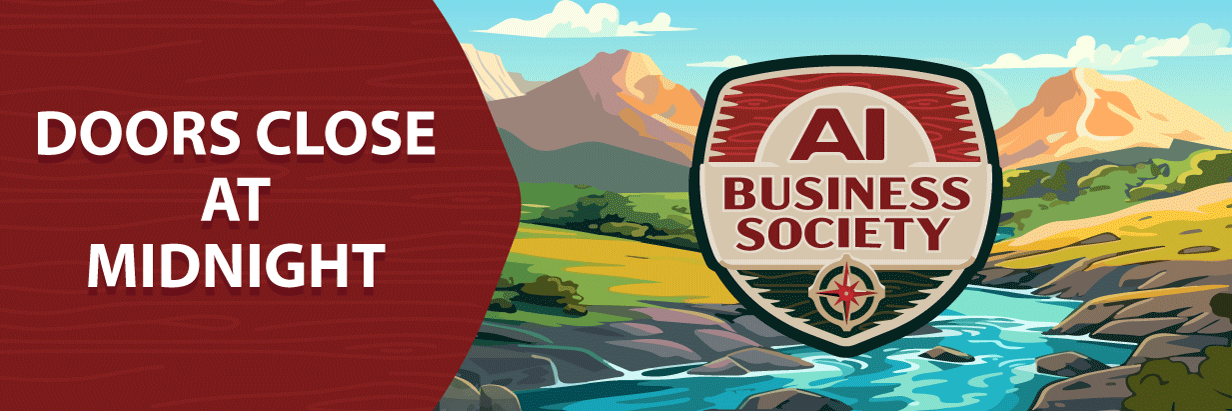Today's Guide to the Marketing Jungle from Social Media Examiner... | Presented by |  |
It's Fountain Pen Day, Alluser! Is there a more elegant way to sign your name?
In today's edition:
-
😡 Today's Tip of the Day is for hacked Facebook and Instagram accounts
-
🕵️ Creative marketing problem-solving
-
🏋️ Reimagining customer-centric marketing
-
🤝 Messaging that promotes change
-
X's latest analytics tool
-
Instagram throttles video quality
-
The latest LinkedIn lead generation feature
-
🗞️ Additional industry news from Instagram, LinkedIn, and more

Have you lost access to your Facebook or Instagram account? Regaining access to a hacked account can be frustrating and lengthy, not to mention impacting your marketing.
Now, Meta has given us a new, potentially faster route for account recovery.
Try a Video Selfie to Recover Your Facebook Account
When you complete all the security steps to recover your account, choose Take a Video Selfie, then select Use Facial Recognition Technology.
Facebook will prompt you through the steps of recording your video.
The process takes only a minute!
Today's tip was inspired by Social Media Examiner's Editorial team.

LAST CHANCE: It's Decision Time, Alluser!
Tonight at midnight the doors to the AI Business Society will close for 2024. If you haven't already joined, now is the time to decide…
While others are still trying to figure out how to use AI in their marketing, you could be:
- Mastering cutting-edge AI tools that drive measurable results
- Implementing proven strategies from successful AI marketers
- Staying ahead of the curve instead of playing catch-up
Your membership includes:
✓ Expert-Led Training from top AI marketing innovators
✓ A Welcoming Community of forward-thinking marketers
✓ Zero-Risk: Try everything 100% risk-free
Being an AI-powered marketer won't be optional in the future. Now is the absolute best time to get started.
Yes, count me in!

How to Leverage AI as a Strategic Marketing Advisor
Do you want to unlock new creative possibilities and strategic advantages to enhance your marketing?
Two weeks ago, we covered levels 1 and 2 of a 5-level framework for progressively integrating AI into your workflows, from basic task assistance to advanced applications like personalized content creation at scale.
Today, we're covering level 3. This step involves using AI tools and custom GPTs tailored to your marketing niche.
Marketing Strategy
Imagine your boss tasks you with increasing sales through social media in the next couple of months, even though you believe email marketing might be more effective.
Open ChatGPT (especially the GPT-4 model and the o1-mini model) or Gemini and describe the situation, including your boss's requirements and your perspective on email marketing. Then, ask the AI to point out anything you might have overlooked in this scenario.
What other details do you need to help me find a solution to this problem?
When the scenario is described fully, you can get the AI's guidance. Here are two prompts to get you started:
I want you to present new perspectives for increasing sales through social media for a mid-sized [business category]. Explore unconventional tactics, such as using AI-generated insights to personalize customer experiences, launching interactive social media campaigns like quizzes or live Q&A sessions, and implementing user-generated content as social proof. Additionally, consider strategies that combine emerging trends, such as social commerce or shoppable posts, with traditional approaches to drive higher conversion rates.
I want you to propose ways to potentially merge social media and email marketing strategies to achieve better results for a mid-sized [business category]. Consider tactics like using social media ads to grow the email list, sharing email content on social platforms, and leveraging email subscribers' data for targeted social media ads. Discuss how to integrate user-generated content, segment audiences based on social media engagement, and create unified messaging across both channels to boost customer engagement and conversion rates.
Target Audience Research
Want to understand current trends and pain points your target audience is thinking about?
Grok analyzes real-time data from X and summarizes current trends, thoughts, and complaints. It then presents examples, showing 5-7 tweets from the target audience that illustrate these trends and complaints.
This real-time market research can inform your strategy, address customer pain points, and capitalize on current trends.
Summarize the top 5 trending topics on X related to [your industry] and analyze the sentiment associated with each.
Alternatively, you can ask:
What are people on X saying about the challenges of [specific problem related to your industry]?
Or:
What are my target audience's main complaints about products like ours?
Customer Satisfaction Analysis
Imagine you've collected numerous customer reviews and testimonials over the years. These are stored in a spreadsheet but haven't been organized or analyzed in depth.
You can use AI to quickly gain structured, data-driven insights from their testimonials without manually reading through each one or creating complex spreadsheet formulas.
First, export the testimonials as a CSV file and upload the file to your preferred AI tool. Then, prompt it to:
I want you to perform the following analysis of a CSV sheet containing customer feedback and testimonials for our restaurant's wine-tasting dinner: 1. Categorize the testimonials into relevant buckets such as Wine Selection, Food Pairings, Service Quality, Ambiance, and Overall Experience. 2. Conduct a quantitative analysis of the categorized data and present the findings in a chart format, showing the frequency of each category. 3. Provide qualitative insights based on the analysis, highlighting trends, common praises, and areas for improvement based on the feedback.
Then, ask the AI to segment the good, the bad, and the ugly for you:
I want you to provide a summary of the customer feedback for each of these categories: 1. Highlight the most positive feedback, focusing on common themes and areas where the experience exceeded expectations. 2. Summarize the most critical comments, identifying recurring issues and areas that need improvement. 3. Identify any surprising or outlier responses that stand out from the general feedback, whether they are exceptionally positive, unusually negative, or simply unique.
Today's advice provided with insights from Dan Sanchez, a featured guest on the AI Explored podcast.

How to Reimagine Customer-Centric Marketing Campaigns
Are your marketing campaigns failing to reach and convert consumers? Do your new campaigns simply echo campaigns you've already run?
A fundamental challenge in marketing is that brands often approach communication from their perspective rather than their audience's.
You work at the brand all day long, and you know everything about it, but the people you're trying to reach don't care about your brand or product until it's relevant to them.
Rather than building a campaign around your product's features, a better approach is to begin with audience context.
When you understand what your audience has going on, you can discover where your brand can naturally intersect and improve their lives.
Asking the AI to generate a social media campaign that gets Gen Zers to want to drink your kombucha will typically result in mediocre, generic output.
Instead, use AI's unparalleled knowledge base to identify surprising connections between your audience's needs and your brand's value proposition.
How to Use AI to Uncover Consumer Truth
First, you must provide the AI context about your brand, target audience, and campaign goals.
When those details are in place, prompt the AI to give you a detailed list of Gen Z attributes and the challenges in their daily lives that could be relevant to your brand.
Using the design thinking framework and cultural tension analysis, what are the potential intersections between Gen Z's daily life challenges and kombucha's benefits?
Based on what you learn, you can prompt the AI to explore all the moments in a Gen Z consumer's day where kombucha could add unexpected value.
Imagine you're following a Gen Z consumer named Alex throughout a typical day. Alex is tech-savvy and cares about health and wellness, but he also enjoys socializing and having fun. They're open to trying new things and are influenced by trends on social media. Explore specific moments in Alex's day where kombucha could provide unexpected value or unique benefits beyond the usual "healthy drink" perception. Think outside the box and consider how kombucha could seamlessly integrate into Alex's lifestyle in new and surprising ways. The goal is to uncover unique and compelling use cases for kombucha that resonate with Gen Z's values, interests, and lifestyle.
For each use case you want to explore, ask the AI for strategic frameworks to consider the customer's challenge from different angles.
I'm trying to reach Gen Z. I want to do a social media campaign around summer and kombucha based on [use case]. What are ten strategic frameworks that could help me understand this challenge and develop inventive solutions?
The AI will propose frameworks like design thinking, blue ocean strategy, cultural tension analysis, generational value mapping, and behavioral economics perspectives.
Take the most compelling or interesting frameworks and ask the AI to analyze your challenge through each framework's specific lens.
You'll likely see multiple surprising connections between different frameworks. You can pull those points and add your own, then prompt the AI to give you campaign ideas based on these nodes.
Please give me social media campaign ideas based on these strategic nodes: 1. Customer Journey Mapping: This framework helps you visualize the different stages a customer goes through, from initial awareness to purchase and beyond. How can you use social media to engage Gen Z consumers with your kombucha brand at each stage of their journey? 2. Jobs to Be Done (JTBD): This framework focuses on understanding your target audience's underlying needs and motivations. What "jobs" are Gen Z consumers hiring kombucha to do in their lives beyond just quenching thirst? Are they seeking a healthy energy boost, a mood lifter, a social lubricant, or a way to express their individuality? 3. Narrative Storytelling: This framework emphasizes the power of stories to connect with an audience on an emotional level. How can you use social media to tell compelling stories about your kombucha brand that resonate with the values and aspirations of Gen Z consumers?
Now, you can use the AI-generated results as a starting point to develop a customized campaign that helps you achieve your goal.
Today's advice provided with insights from Jenny Nicholson, a featured guest on the AI Explored podcast.

The Countdown Is On, Alluser!
At midnight tonight, two things happen:
- The AI Business Society doors close until 2025
- The discounted annual member rate (57% off) disappears
While others spend the rest of 2024 trying to figure out AI, you'll be:
✓ Generating more revenue with AI-powered marketing campaigns
✓ Saving 10+ hours weekly due to increased productivity
✓ Creating high-converting content in minutes, not days
✓ Making faster, informed decisions that have others praising you
I don't want to miss out!

How to Build Messages That Build Buy-In for Change
Are you struggling to implement changes in your marketing strategy? Wondering how to get buy-in from skeptical team members or consumers?
In this article, we'll explore how to create messages that get people to embrace change inside a business.
Change is a constant in the business world, yet it remains one of the most challenging aspects for marketers and organizations to navigate successfully.
Whether introducing new technology, a new product, or shifting market strategy, the path to change is often marked by resistance, setbacks, and sometimes outright failure.
The question isn't whether change will come; it's how we can better navigate it when it does.
Understanding the psychological barriers to change is crucial for developing effective strategies to overcome resistance and drive the adoption of new ideas, technologies, or processes.
So, why are we resistant to change?
Risk Aversion: Risk aversion is at the core of change resistance. People naturally want to protect what they have, whether it's a brand they're loyal to, a stable work environment, proven processes, or a sense of competence in their role. Introducing change disrupts this stability and can trigger fears of loss or failure.
Identity of Self: Resistance to change often goes deeper than practical concerns. It can challenge people's self-concept and desired identity as it relates to a brand or product they're loyal to. We all want to be seen as intelligent, capable, and good. Proposed changes that seem to conflict with these self-perceptions can face significant pushback.
This complexity means that successfully driving change requires a nuanced approach that addresses resistance's logical and emotional aspects.
Messaging expert Tamsen Webster shared her process for communicating change to your customers, colleagues, and peers in a way that persuades them to move forward with you. Today, we bring you part 1. Look for part 2 on Monday.
Anchor Change to Existing Beliefs
Suppose you're tasked with driving change with a new product offering–similar to Apple introducing the iPod. Or you've been asked to create messaging to drive the adoption of AI within your company.
Rather than imposing change from above, successful transformations often begin with careful listening.
Whether you're speaking to internal staff or consumers, it is crucial to anchor your proposal to questions or challenges your stakeholders are already actively considering because change lands differently when it's anchored to existing pain points.
To identify critical anchors, look for persistent irritants or ongoing challenges in your organization or industry. These don't always have to be significant pain points – even minor, consistent frustrations can be powerful motivators for change.
To uncover these anchor points, you can:
-
Examine company strategic priorities and ask what your organization's ongoing or current focus areas are.
-
Consider industry-wide challenges and ask what persistent issues your sector faces.
-
Conduct stakeholder interviews and ask team members and clients about their day-to-day frustrations and long-term goals.
-
You can even leverage AI assistants like ChatGPT to generate potential questions based on your target audience persona.
Remember, the goal is to find questions your audience is actively and knowingly asking right now. By aligning your proposed change with these existing concerns, you can create a natural bridge between current challenges and your solution, increasing the likelihood of acceptance and adoption.
Once you've identified potential questions, evaluate them against a business version of Maslow's Hierarchy of needs.
Maslow's Hierarchy as it Relates to Consumers
Physiological Needs: These are consumers' basic needs for survival and comfort. In a consumer context, this often translates to products that fulfill essential needs. Products like groceries, affordable housing, comfortable clothing, and medications fulfill these needs. The marketing focus on physiological needs communicates functionality, affordability, and reliability.
Safety Needs: Consumers need to feel safe and secure when making purchases and interacting with a brand. Security systems, insurance, reliable transportation, warranties, secure online transactions, and data privacy fulfill these needs. The marketing focus on safety needs should highlight safety features, guarantees, trust signals, and long-term benefits.
Love/Belonging Needs: Consumers want to feel a sense of belonging and connection with a brand or community. Social media platforms, brand communities, loyalty programs, and products that foster connection (like games, shared experiences, or gifts) help fulfill these needs. The marketing focus for Love/Belonging needs involves social proof, community building, shared values, emotional connection, and personalized experiences.
Esteem Needs: Consumers want to feel good about themselves and their choices. They seek products and brands that enhance their self-image and status. Luxury goods, premium brands, educational courses, self-improvement products, recognition programs, and exclusive experiences fulfill these needs. The marketing focus for esteem needs highlights exclusivity, quality, status, achievement, personal growth, and recognition.
Self-Actualization Needs: Consumers want to reach their full potential and express their individuality. They seek products and experiences that help them grow and achieve their goals. Creative tools, travel experiences, personal development programs, charities, sustainable products, and unique and customizable products fulfill these needs. The marketing focus for self-actualization emphasizes purpose, creativity, self-expression, personal growth, transformation, and making a difference.
Which level(s) of the Hierarchy are most important to them? How does your change meet those needs?
Maslow's Hierarchy as it Relates to Internal Stakeholders
Physiological Needs: These are the basic needs for survival, such as fair pay, regular breaks, and a comfortable working environment. Without these, employees cannot focus on their work.
Safety Needs: Employees need to feel safe and secure in their jobs. This includes job security, safe working conditions, and benefits like health insurance and retirement plans.
Social Needs: Employees need to feel a sense of belonging and connection with their colleagues. This can be fostered through team-building activities, social events, and a positive work environment.
Esteem Needs: Employees need to feel valued and appreciated for their work. Recognition, promotions, and opportunities for growth and development can achieve this.
Self-Actualization Needs: This is the need to reach one's full potential. In a business context, it means providing employees with challenging and fulfilling work, opportunities for creativity and innovation, and the autonomy to make decisions.
Which level(s) of the Hierarchy are most important to your staff and leadership? How does your change meet or exceed those needs?
Next week, we cover creating and delivering your messaging.
Today's advice is provided with insights from Tamsen Webster, a featured guest on the Social Media Marketing Podcast.

Instagram Smart Content Quality Management System: Adam Mosseri has unveiled a new dynamic content delivery system that will automatically adjust the quality of Reels, Stories, and Photos based on multiple factors, including network conditions and viewing patterns. The platform will now intelligently manage content quality, starting with the highest possible quality when content is first posted. However, if a post receives minimal engagement after its initial viewing period, the system automatically switches to a lower-quality version to optimize platform resources. Source: Engadget
LinkedIn Post Boosting: LinkedIn has announced a new feature allowing companies to boost posts specifically for lead generation purposes; this new feature enables companies to convert their organic posts into advertisements that can reach beyond their current Page followers. The latest lead generation boosting feature is available worldwide and supports all languages on mobile and desktop platforms. Source: LinkedIn
LinkedIn UI Changes: LinkedIn is testing a new mobile app interface by consolidating the navigation options into a single top bar. Source: Social Media Today
Meta Releases 3rd Quarter Results: Meta's Family of Apps reached an average of 3.29 billion daily active users in September 2024, representing a 5% increase compared to the same period in the previous year. The company experienced a 7% year-over-year increase in ad impressions delivered across its Family of Apps. The average price per advertisement rose by 11% compared to the same period in the previous year. Source: Meta
Meta Ads Insights: As of October 30, 2024, specific unique metrics have been removed from the Ads Insights API. Specifically, the unique_actions and cost_per_unique_action_type fields will no longer provide data for several action_type breakdowns. The fields that count total actions will remain unchanged, including the actions and cost_per_action_type fields. These total action fields will continue to support all existing action_type breakdowns. Source: Meta
X API Fees Rise: The Basic tier on X now costs $200 per month, twice its previous price. X has also introduced an annual subscription plan with a discounted rate. Source: @XDailyNews via X
YouTube Updates: The platform has announced several updates to improve content organization and community engagement. The Studio Mobile Content Tab now features a cleaner layout with dedicated shelves for different content types, showing monetization and visibility status only when relevant. The Comments Tab is being rebranded as "Community" and will include new features like audience metrics and a Community Spotlight to highlight engaged viewers. The platform is expanding its AI capabilities with enhanced comment reply suggestions and video summaries for English-language content. These features will roll out gradually to creators over the coming weeks. Source: YouTube
X Analytics: The platform announced an expanded release of its real time trend analysis tool, which has been renamed from Insights to Radar. The tool enables users to identify emerging trends as they develop in real time. The initial rollout of Radar begins today and will be available to a limited group of Premium+ subscribers. Source:@Premium via X
X Lightening Notes: Notes can now appear on posts much faster - in some cases, just 14 minutes and 33 seconds after someone writes the note. Source: @CommunityNotes via X
Apple AI Tools: Apple has begun rolling out its new AI tools to select iPhone users worldwide, branded as Apple Intelligence. The release, available Monday through iOS 18.1, requires users to join a waitlist after updating their devices, with activation expected within hours of registration. The initial feature set includes enhanced notification summaries, message composition assistance, and a revamped Siri interface with improved AI capabilities. Source: BBC
Claude Analysis Tool: This built-in feature allows Claude to write and run JavaScript code and is currently available to all Claude.ai users in feature preview. The tool functions as a code sandbox where Claude can perform complex mathematical calculations, analyze data, and test different approaches before providing answers. The new functionality enables Claude to work like a data analyst by systematically processing data through cleaning, exploration, and step-by-step analysis to reach accurate results. The tool can analyze CSV files and help various teams, including marketing teams analyzing customer interactions, sales teams examining global sales data, product managers reviewing customer engagement, engineers evaluating server performance logs, and finance teams creating financial dashboards from monthly data. Source: Anthropic
Google AI Overviews: This week, the summarizing feature is expanding across more than 100 countries and territories. Source: Google
Grok Image Analysis: A significant update to the Grok AI chatbot enables image-understanding capabilities that allow paid users to upload an image and ask Grok questions to learn more about it. Source: TechCrunch
Meta Podcast Generator: Meta has taken the "generate-a-podcast" feature that went viral in Google's NotebookLM and created their version of it, called NotebookLlama, which they've made open source. Source: TechCrunch
Midjourney Image Editing Tools: The company announced two new features for testing: an image editor for uploaded images and an image re-texturing tool that allows exploration of materials, surfacing, and lighting effects. Both new features are compatible with our existing advanced capabilities, including style references, character references, and personalized models. These features will initially be available to three specific user groups: those with yearly memberships, subscribers who have maintained their membership for the past 12 months, and members who have generated at least 10,000 images. Source: @Midjourney via X
What Did You Think of Today's Newsletter?
Did You Know?
Ravens and crows speak the same way parrots do!

Michael Stelzner, Founder and CEO
P.S. Add
michael@socialmediaexaminer.com into your contacts list. Use Gmail?
Go here to add us as a contact.
We publish updates with links for our new posts and content from partners. Your information: Email:
tukangpostemel@gmail.com Opted in on: 2021-09-06 17:03:43 UTC.










